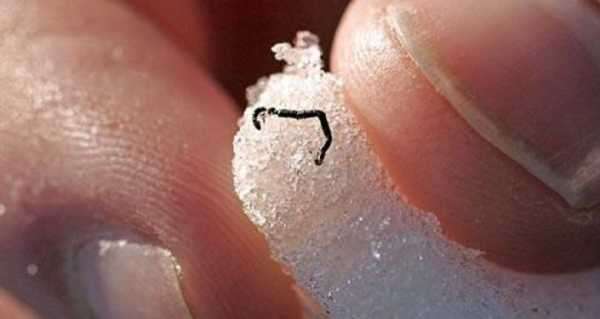
When Peter Wimberger of the University of Puget Sound was first told about ice worms, he thought that his colleagues were pranking him. Imagine his surprise when he learned that not only are these creatures real, they are full of mysteries that if solved, could help answer one of the biggest questions in science.
Ice worms have been spotted at the Paradise Glacier in Washington, local media reported. One could easily mistake these itsy-bitsy creatures for a thread or simply fail to notice them due to their small size.
There are millions of these animals across the world and yet despite their abundance, they have barely been studied, with scientists treating them as a mere curiosity. Scott Hotaling, a glacier biologist from Washington State University, and his colleague Peter Wimberger have been studying ice worms for several years.
As the name implies, ice worms live in cold environments, often glaciers, hiding in the snow and ice. Hotaling jokes that if one had to choose a mascot for glaciers, there is no better candidate than the ice worm.
Unlike humans, who lose energy when they are in a cold environment, ice worms thrive in the cold and their energy levels go up when they are subjected to low temperatures. They live comfortably at 32 degrees Fahrenheit (0 degrees Celsius), but if temperatures dip slightly below that, they die.
They eat snow algae and bacteria, but according to Scott Hotaling, they don’t need a lot of food. “I’ve kept them in my fridge, in my home, for physiology experiments, for a year or more, without adding anything to their system, and they’re fine”, he said.
Mysteries and Scientific Breakthroughs
As mentioned earlier, ice worms are shrouded in mystery. Scientists still don’t know why these animals appear in snow and ice. Another riddle is their lifespan and how they survive and reproduce during harsh winters.
Scientists believe these enigmatic creatures might reveal how life can exist in extreme environments and consequently solve the mysteries about potential life on other colder planets, like Mars. Their future, however, is in jeopardy, as glaciers have been melting across the world, including in the Arctic. Researchers say that if ice worms don’t adapt to the changing world, they may face extinction.
Hotaling wonders whether ice worms might be a reason why glaciers are melting so fast. It is believed that the presence of dark-coloured algae can speed up glacial melting; it is furthermore possible that the worms’ dark bodies absorb heat and thus also contribute to the process.
Sourse: sputniknews.com






